Kuikun Liu
RIG: Synergizing Reasoning and Imagination in End-to-End Generalist Policy
Mar 31, 2025Abstract:Reasoning before action and imagining potential outcomes (i.e., world models) are essential for embodied agents operating in complex open-world environments. Yet, prior work either incorporates only one of these abilities in an end-to-end agent or integrates multiple specialized models into an agent system, limiting the learning efficiency and generalization of the policy. Thus, this paper makes the first attempt to synergize Reasoning and Imagination in an end-to-end Generalist policy, termed RIG. To train RIG in an end-to-end manner, we construct a data pipeline that progressively integrates and enriches the content of imagination and reasoning in the trajectories collected from existing agents. The joint learning of reasoning and next image generation explicitly models the inherent correlation between reasoning, action, and dynamics of environments, and thus exhibits more than $17\times$ sample efficiency improvements and generalization in comparison with previous works. During inference, RIG first reasons about the next action, produces potential action, and then predicts the action outcomes, which offers the agent a chance to review and self-correct based on the imagination before taking real actions. Experimental results show that the synergy of reasoning and imagination not only improves the robustness, generalization, and interoperability of generalist policy but also enables test-time scaling to enhance overall performance.
Exploring the Limit of Outcome Reward for Learning Mathematical Reasoning
Feb 10, 2025Abstract:Reasoning abilities, especially those for solving complex math problems, are crucial components of general intelligence. Recent advances by proprietary companies, such as o-series models of OpenAI, have made remarkable progress on reasoning tasks. However, the complete technical details remain unrevealed, and the techniques that are believed certainly to be adopted are only reinforcement learning (RL) and the long chain of thoughts. This paper proposes a new RL framework, termed OREAL, to pursue the performance limit that can be achieved through \textbf{O}utcome \textbf{RE}w\textbf{A}rd-based reinforcement \textbf{L}earning for mathematical reasoning tasks, where only binary outcome rewards are easily accessible. We theoretically prove that behavior cloning on positive trajectories from best-of-N (BoN) sampling is sufficient to learn the KL-regularized optimal policy in binary feedback environments. This formulation further implies that the rewards of negative samples should be reshaped to ensure the gradient consistency between positive and negative samples. To alleviate the long-existing difficulties brought by sparse rewards in RL, which are even exacerbated by the partial correctness of the long chain of thought for reasoning tasks, we further apply a token-level reward model to sample important tokens in reasoning trajectories for learning. With OREAL, for the first time, a 7B model can obtain 94.0 pass@1 accuracy on MATH-500 through RL, being on par with 32B models. OREAL-32B also surpasses previous 32B models trained by distillation with 95.0 pass@1 accuracy on MATH-500. Our investigation also indicates the importance of initial policy models and training queries for RL. Code, models, and data will be released to benefit future research\footnote{https://github.com/InternLM/OREAL}.
Are Your LLMs Capable of Stable Reasoning?
Dec 17, 2024Abstract:The rapid advancement of Large Language Models (LLMs) has demonstrated remarkable progress in complex reasoning tasks. However, a significant discrepancy persists between benchmark performances and real-world applications. We identify this gap as primarily stemming from current evaluation protocols and metrics, which inadequately capture the full spectrum of LLM capabilities, particularly in complex reasoning tasks where both accuracy and consistency are crucial. This work makes two key contributions. First, we introduce G-Pass@k, a novel evaluation metric that provides a continuous assessment of model performance across multiple sampling attempts, quantifying both the model's peak performance potential and its stability. Second, we present LiveMathBench, a dynamic benchmark comprising challenging, contemporary mathematical problems designed to minimize data leakage risks during evaluation. Through extensive experiments using G-Pass@k on state-of-the-art LLMs with LiveMathBench, we provide comprehensive insights into both their maximum capabilities and operational consistency. Our findings reveal substantial room for improvement in LLMs' "realistic" reasoning capabilities, highlighting the need for more robust evaluation methods. The benchmark and detailed results are available at: https://github.com/open-compass/GPassK.
MindSearch: Mimicking Human Minds Elicits Deep AI Searcher
Jul 29, 2024



Abstract:Information seeking and integration is a complex cognitive task that consumes enormous time and effort. Inspired by the remarkable progress of Large Language Models, recent works attempt to solve this task by combining LLMs and search engines. However, these methods still obtain unsatisfying performance due to three challenges: (1) complex requests often cannot be accurately and completely retrieved by the search engine once (2) corresponding information to be integrated is spread over multiple web pages along with massive noise, and (3) a large number of web pages with long contents may quickly exceed the maximum context length of LLMs. Inspired by the cognitive process when humans solve these problems, we introduce MindSearch to mimic the human minds in web information seeking and integration, which can be instantiated by a simple yet effective LLM-based multi-agent framework. The WebPlanner models the human mind of multi-step information seeking as a dynamic graph construction process: it decomposes the user query into atomic sub-questions as nodes in the graph and progressively extends the graph based on the search result from WebSearcher. Tasked with each sub-question, WebSearcher performs hierarchical information retrieval with search engines and collects valuable information for WebPlanner. The multi-agent design of MindSearch enables the whole framework to seek and integrate information parallelly from larger-scale (e.g., more than 300) web pages in 3 minutes, which is worth 3 hours of human effort. MindSearch demonstrates significant improvement in the response quality in terms of depth and breadth, on both close-set and open-set QA problems. Besides, responses from MindSearch based on InternLM2.5-7B are preferable by humans to ChatGPT-Web and Perplexity.ai applications, which implies that MindSearch can already deliver a competitive solution to the proprietary AI search engine.
CIBench: Evaluating Your LLMs with a Code Interpreter Plugin
Jul 15, 2024


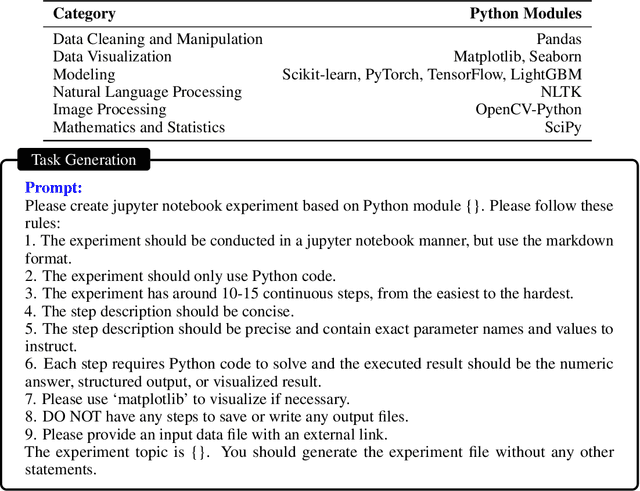
Abstract:While LLM-Based agents, which use external tools to solve complex problems, have made significant progress, benchmarking their ability is challenging, thereby hindering a clear understanding of their limitations. In this paper, we propose an interactive evaluation framework, named CIBench, to comprehensively assess LLMs' ability to utilize code interpreters for data science tasks. Our evaluation framework includes an evaluation dataset and two evaluation modes. The evaluation dataset is constructed using an LLM-human cooperative approach and simulates an authentic workflow by leveraging consecutive and interactive IPython sessions. The two evaluation modes assess LLMs' ability with and without human assistance. We conduct extensive experiments to analyze the ability of 24 LLMs on CIBench and provide valuable insights for future LLMs in code interpreter utilization.
AlchemistCoder: Harmonizing and Eliciting Code Capability by Hindsight Tuning on Multi-source Data
May 29, 2024Abstract:Open-source Large Language Models (LLMs) and their specialized variants, particularly Code LLMs, have recently delivered impressive performance. However, previous Code LLMs are typically fine-tuned on single-source data with limited quality and diversity, which may insufficiently elicit the potential of pre-trained Code LLMs. In this paper, we present AlchemistCoder, a series of Code LLMs with enhanced code generation and generalization capabilities fine-tuned on multi-source data. To achieve this, we pioneer to unveil inherent conflicts among the various styles and qualities in multi-source code corpora and introduce data-specific prompts with hindsight relabeling, termed AlchemistPrompts, to harmonize different data sources and instruction-response pairs. Additionally, we propose incorporating the data construction process into the fine-tuning data as code comprehension tasks, including instruction evolution, data filtering, and code review. Extensive experiments demonstrate that AlchemistCoder holds a clear lead among all models of the same size (6.7B/7B) and rivals or even surpasses larger models (15B/33B/70B), showcasing the efficacy of our method in refining instruction-following capabilities and advancing the boundaries of code intelligence.
InternLM2 Technical Report
Mar 26, 2024
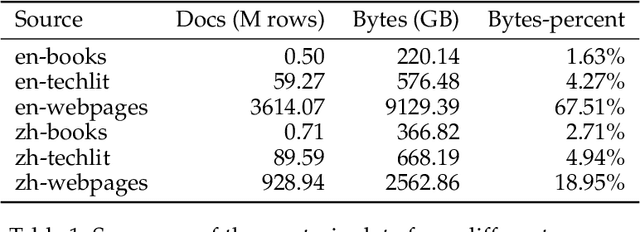
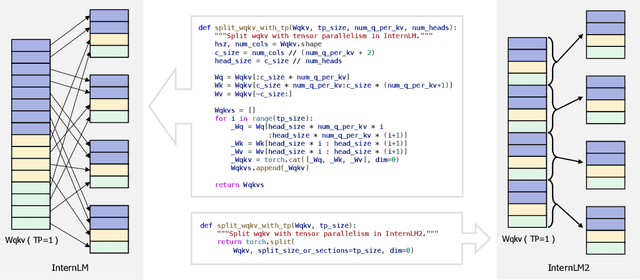

Abstract:The evolution of Large Language Models (LLMs) like ChatGPT and GPT-4 has sparked discussions on the advent of Artificial General Intelligence (AGI). However, replicating such advancements in open-source models has been challenging. This paper introduces InternLM2, an open-source LLM that outperforms its predecessors in comprehensive evaluations across 6 dimensions and 30 benchmarks, long-context modeling, and open-ended subjective evaluations through innovative pre-training and optimization techniques. The pre-training process of InternLM2 is meticulously detailed, highlighting the preparation of diverse data types including text, code, and long-context data. InternLM2 efficiently captures long-term dependencies, initially trained on 4k tokens before advancing to 32k tokens in pre-training and fine-tuning stages, exhibiting remarkable performance on the 200k ``Needle-in-a-Haystack" test. InternLM2 is further aligned using Supervised Fine-Tuning (SFT) and a novel Conditional Online Reinforcement Learning from Human Feedback (COOL RLHF) strategy that addresses conflicting human preferences and reward hacking. By releasing InternLM2 models in different training stages and model sizes, we provide the community with insights into the model's evolution.
Agent-FLAN: Designing Data and Methods of Effective Agent Tuning for Large Language Models
Mar 19, 2024Abstract:Open-sourced Large Language Models (LLMs) have achieved great success in various NLP tasks, however, they are still far inferior to API-based models when acting as agents. How to integrate agent ability into general LLMs becomes a crucial and urgent problem. This paper first delivers three key observations: (1) the current agent training corpus is entangled with both formats following and agent reasoning, which significantly shifts from the distribution of its pre-training data; (2) LLMs exhibit different learning speeds on the capabilities required by agent tasks; and (3) current approaches have side-effects when improving agent abilities by introducing hallucinations. Based on the above findings, we propose Agent-FLAN to effectively Fine-tune LANguage models for Agents. Through careful decomposition and redesign of the training corpus, Agent-FLAN enables Llama2-7B to outperform prior best works by 3.5\% across various agent evaluation datasets. With comprehensively constructed negative samples, Agent-FLAN greatly alleviates the hallucination issues based on our established evaluation benchmark. Besides, it consistently improves the agent capability of LLMs when scaling model sizes while slightly enhancing the general capability of LLMs. The code will be available at https://github.com/InternLM/Agent-FLAN.
InternLM-Math: Open Math Large Language Models Toward Verifiable Reasoning
Feb 09, 2024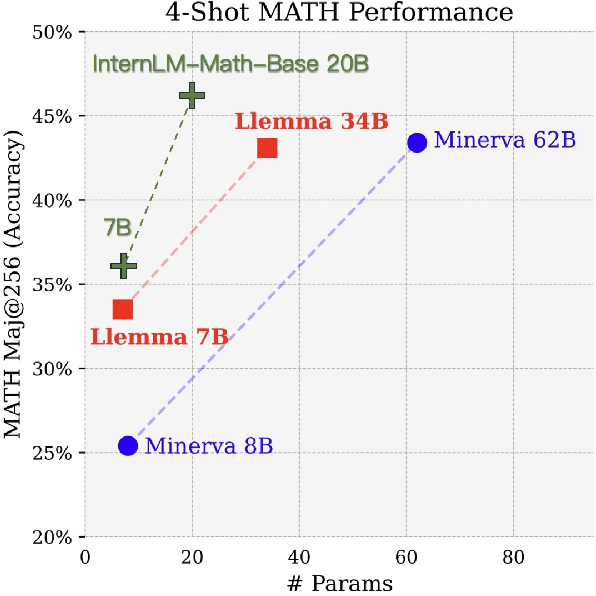

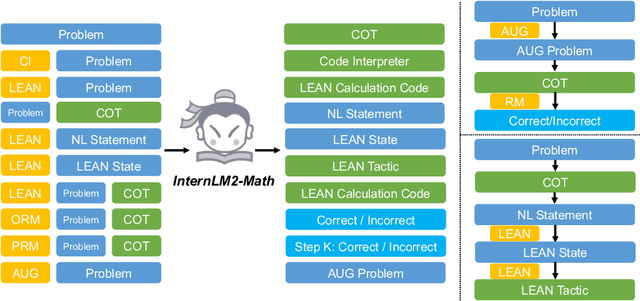
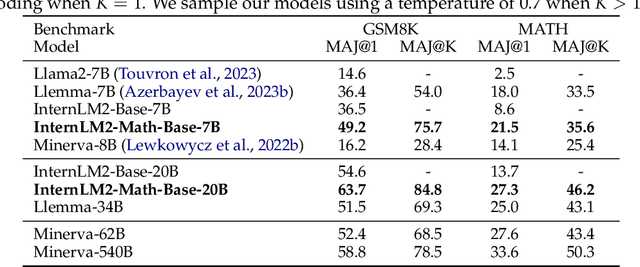
Abstract:The math abilities of large language models can represent their abstract reasoning ability. In this paper, we introduce and open-source our math reasoning LLMs InternLM-Math which is continue pre-trained from InternLM2. We unify chain-of-thought reasoning, reward modeling, formal reasoning, data augmentation, and code interpreter in a unified seq2seq format and supervise our model to be a versatile math reasoner, verifier, prover, and augmenter. These abilities can be used to develop the next math LLMs or self-iteration. InternLM-Math obtains open-sourced state-of-the-art performance under the setting of in-context learning, supervised fine-tuning, and code-assisted reasoning in various informal and formal benchmarks including GSM8K, MATH, Hungary math exam, MathBench-ZH, and MiniF2F. Our pre-trained model achieves 30.3 on the MiniF2F test set without fine-tuning. We further explore how to use LEAN to solve math problems and study its performance under the setting of multi-task learning which shows the possibility of using LEAN as a unified platform for solving and proving in math. Our models, codes, and data are released at \url{https://github.com/InternLM/InternLM-Math}.
T-Eval: Evaluating the Tool Utilization Capability of Large Language Models Step by Step
Jan 15, 2024Abstract:Large language models (LLM) have achieved remarkable performance on various NLP tasks and are augmented by tools for broader applications. Yet, how to evaluate and analyze the tool-utilization capability of LLMs is still under-explored. In contrast to previous works that evaluate models holistically, we comprehensively decompose the tool utilization into multiple sub-processes, including instruction following, planning, reasoning, retrieval, understanding, and review. Based on that, we further introduce T-Eval to evaluate the tool utilization capability step by step. T-Eval disentangles the tool utilization evaluation into several sub-domains along model capabilities, facilitating the inner understanding of both holistic and isolated competency of LLMs. We conduct extensive experiments on T-Eval and in-depth analysis of various LLMs. T-Eval not only exhibits consistency with the outcome-oriented evaluation but also provides a more fine-grained analysis of the capabilities of LLMs, providing a new perspective in LLM evaluation on tool-utilization ability. The benchmark will be available at https://github.com/open-compass/T-Eval.
 Add to Chrome
Add to Chrome Add to Firefox
Add to Firefox Add to Edge
Add to Edge